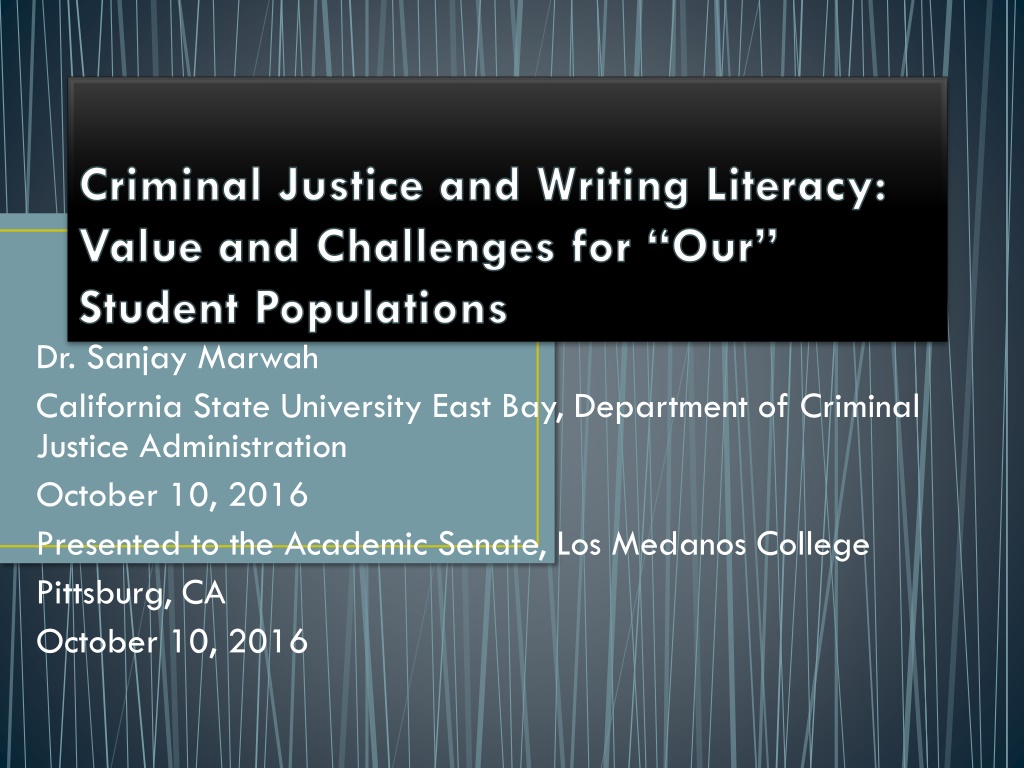
Writing Literacy Value and Challenges in Criminal Justice Education
Explore the value and challenges of writing literacy for student populations in the field of criminal justice. Discover how writing is thinking on paper and the importance of connecting content to cognition in education. Learn about educator roles in fostering writing skills as a transferable skill for students.
Download Presentation

Please find below an Image/Link to download the presentation.
The content on the website is provided AS IS for your information and personal use only. It may not be sold, licensed, or shared on other websites without obtaining consent from the author. Download presentation by click this link. If you encounter any issues during the download, it is possible that the publisher has removed the file from their server.
E N D
Presentation Transcript
Criminal Justice and Writing Literacy: Value and Challenges for Our Student Populations Dr. Sanjay Marwah California State University East Bay, Department of Criminal Justice Administration October 10, 2016 Presented to the Academic Senate, Los Medanos College Pittsburg, CA October 10, 2016
Writing is thinking on paper, or talking to someone on paper. If you can think clearly, or if you can talk to someone about the things you know and care about, you can write - with confidence and enjoyment. William Zinsser in Writing Well (1976)
Diversity: Content to Cognition Why start here? Student needs not being served Not only learning styles but purpose of learning Students see little connections & value We work for their learning Faculty view content of learning as separate from communication of learning (cognition) 21st century cognition much greater than content Life-long learning Consequences Career High-Stakes
Educators Roles & Healthy Practices Facilitators vs. Lecturers Develop and practice skills in low-stakes environments Provide opportunities & quality feedback Use for your instruction Assessors vs. Evaluators Improvements with less focus on grades Learning from mistakes Integrate to assignments Motivators vs. Judges Humanize learning content & skills Articulate situations connected to real-world & professional communication Judge less, Reinforce more
Writing Universal Content to Transferable Skill Today Students See Writing for Factual Purposes Students Struggle with Comprehension Not Know Audience/Readership Students Perceive One Size Fits All Not Confident in Their Abilities Tomorrow Students Organize & Craft Students Appreciate Challenges in Comprehension Audience Allow for Clarity and Organization of Writing Adjust & Be Flexible Growing Confidence with Diligence to Process & Improvement
One day in 1987 I received a letter from Joan Countyman, head of the mathematics department at Germantown Friends School in Philadelphia. She had heard about my interest in the educational movement called writing across the curriculum. For many years, she said, I ve been asking my students to write about mathematics as they learned it, with predictably wonderful results. Writing frees them of the idea that math is a collection of right answers owned by the teacher a body of knowledge that she will dispense in chunks and that they have to swallow and digest. That's how most non-mathematicians perceive it. But what makes mathematics really interesting is not the right answer but where it came from and where it leads. William Zinsser in Writing to Learn (1993)
